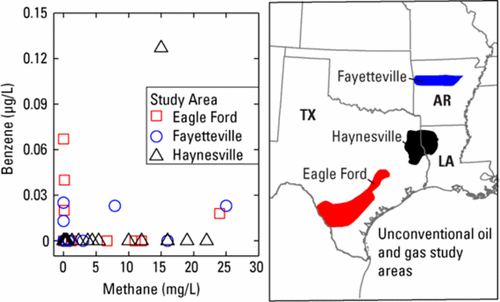USGS examines water wells in Eagle Ford, Haynesville, Fayetteville aquifers
The USGS published a study last week investigating the effects of oil and gas production on drinking water quality.
The study examined a total of 116 water wells in Texas, Louisiana and Arkansas, in areas were companies are producing from the Eagle Ford, Haynesville and Fayetteville.
Water samples were tested for methane, benzene and several other chemicals that help determine the age of the groundwater.

Benzene found in nine wells at low concentrations
The study found low concentrations of benzene in nine wells. Four wells in the Eagle Ford region, four in the Fayetteville and one in the Haynesville had traces of benzene. The highest concentration was detected in the Haynesville well, where concentrations of about 0.13 micrograms/liter were found. For reference, federal standards require benzene concentrations in drinking water to be below 5 micrograms per liter. Benzene is naturally occurring in trace amounts within petroleum and coal formations, but is also found in some fracturing fluids.
Biogenic methane found in most wells
Methane was detected in the vast majority of wells; 91% of those sampled had some methane present. About 10% of wells with methane present had concentrations above the suggested maximum. While methane is not toxic, it is highly explosive and therefore the Department of the Interior has suggested water should have methane concentrations below 10 milligrams/liter. Methane was detected wells in each of the three regions.
Methane is the primary component of natural gas, and is also often produced by underground bacteria. Scientists can distinguish between methane produced by bacteria and methane produced by heat and pressure, the process that creates shale gas.
The USGS reports that most of the methane detected in groundwater in this study was from naturally occurring sources at shallow depths rather than shale gas.
Groundwater age helped scientists determine source of benzene
The USGS study was able to estimate the age of the groundwater tested, which can help determine the source of any benzene detected. In Louisiana and Texas water mostly had been in the aquifers for several thousand years. This indicates that any benzene detected was either due to natural hydrocarbon migration or oil and gas wells with subsurface leaks.
In Arkansas, by contrast, water tested was relatively young, and had usually been in the aquifer for less than 40 years. This led the USGS to conclude that one of the wells with benzene present may have been due to a spill on the surface, likely the result of oil and gas production activities.
Bottom line: development of unconventional resources not a significant source of water contamination
Overall, however, the USGS concludes that in the regions sampled unconventional oil and gas production is not currently a significant source of methane or benzene to drinking water wells.


